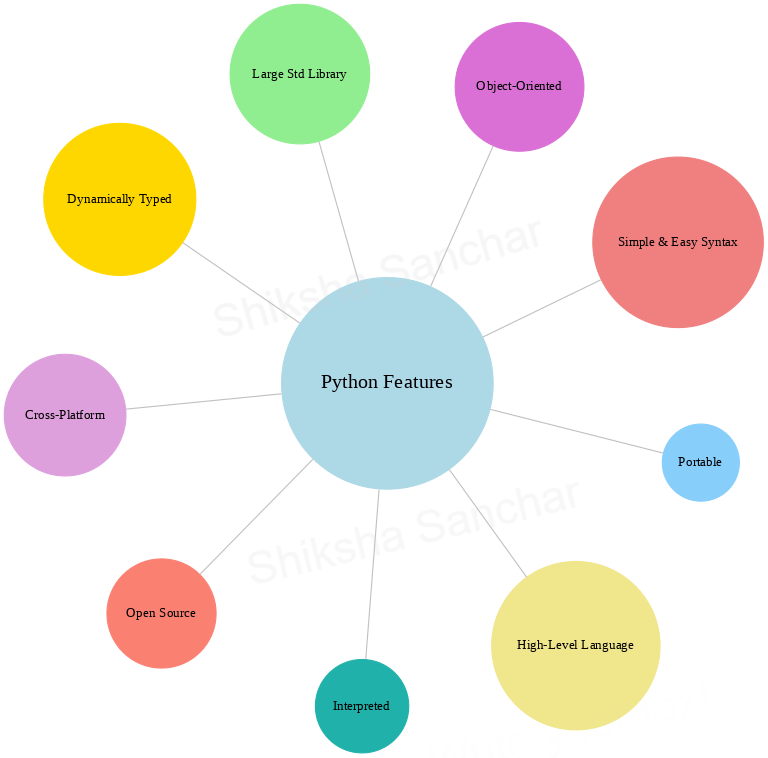Features of Python
Python is a very powerful and easy-to-learn programming language. It was created by Guido van Rossum and released in 1991. Python supports multiple programming paradigms and is widely used in web development, data science, automation, artificial intelligence, and more. Its simple syntax makes it popular among both beginners and professionals. Python is a very powerful and easy-to-learn programming language. It has many features that make it popular for both beginners and professionals.
Python Features

1. Simple Syntax
Python code is clean and easy to read. It looks similar to English, which makes learning faster and easier for beginners.
- No need to use curly braces or semicolons.
- Indentation is used to define code blocks, which improves readability.
2. Interpreted Language
Python is an interpreted language, which means the code is run line by line, not all at once. You don’t need to compile the whole program before running it. Python directly reads and runs each line of code.
This makes it easier to find and fix errors (called debugging) and test parts of the program quickly. This feature makes Python a good choice for beginners and rapid development.
3. Dynamically Typed
In Python, you don’t need to declare the type of variable. The type is decided during runtime based on the value you assign.
x = 10 # x is an integer
x = "Python" # Now x is a stringNo error. Variable x changed from int to string.
4. Object-Oriented
Python supports object-oriented programming. It allows you to create classes and objects to organize and reuse your code easily. This makes the code easier to manage, reuse, and update – especially when working on larger projects.
This makes the code easier to manage, reuse, and update – especially when working on larger projects. It makes the code more modular, reusable, and easy to understand. Python supports all four main OOP features are Encapsulation, Abstraction, Inheritance, and Polymorphism.
5. Portable
You can run the same Python code on different operating systems like Windows, Mac, or Linux without any changes. This makes Python platform-independent.
6. Large Standard Library
Python provides a wide range of built-in libraries for file handling, math, web development, data processing, and much more.
7. Open Source
Python is an open-source language, which means it is free to use, and its source code is publicly available. Anyone can download, use, change, and share Python without paying anything. You can use Python freely for personal, educational, or commercial purposes.
Python is an open-source language, which means it is free to use, and its source code is publicly available. Anyone can download, use, change, and share Python without paying anything.
8. Extensible
You can combine Python with other languages like C, C++, or Java to increase speed or use existing code.
9. GUI Support
Python supports GUI (Graphical User Interface), which means you can create windows, buttons, forms, menus, and other visual elements that users can click and interact with – just like any app or software with a nice look. Instead of only using text-based programs, Python allows you to create interactive and attractive applications using GUI libraries.
Python supports GUI (Graphical User Interface) development using libraries like Tkinter, PyQt, Kivy, wxPython etc. You can build windows-based applications easily.
10. High-Level Language
A high-level language is a user-friendly programming language that is easy to read, write, and understand. It is designed in a way that humans can understand easily, just like English.
Python is a high-level language, which means you do not need to worry about complex tasks like memory management or hardware instructions. The language itself takes care of these things for you.
11. Free and Open Source
Python is free to download and use. Its source code is open, so developers can study or modify it anytime.
12. Platform Independent
Platform Independent means that the same Python program can run on different operating systems (like Windows, Mac, Linux, etc.) without changing the code. You just write the code once, and it can run anywhere, as long as Python is installed on that system.
Write once, run anywhere. Python programs work on any operating system without changing the code.
13. Large Community Support
Python has a huge user base. If you face any problem, you can easily find help through forums, videos, or official documentation.
14. Easy to Integrate
Python works well with other languages like C, C++, Java, and .NET, making it suitable for large systems.
15. Automatic Memory Management
You don’t need to worry about memory allocation or deallocation. Python handles it automatically in the background.
16. Multi-purpose Language
Python is used in various fields:
- Web Development – Flask, Django
- Data Science – Pandas, NumPy
- Machine Learning – scikit-learn, TensorFlow
- Game Development – Pygame
- GUI Applications – Tkinter
17. Built-in Functions
Built-in functions are pre-defined functions provided by Python. Python has many ready-to-use functions like print(), range(), etc., which save time and make coding easier.
Built-in functions are the ready-made functions that come with Python. You don’t have to write them yourself – you can just use them directly to do common tasks like printing something, finding the length of a string, creating a list of numbers, etc.
Examples: print(), len(), range(), type(), input() and many more.
18. Example Program
The below program adds two numbers and displays the result:
a = 10
b = 5
sum = a + b
print("Sum:", sum)Sum: 15
This simple Python program adds two numbers and prints the result using the print() function.
These features make Python a powerful, flexible, and easy-to-use language.